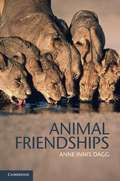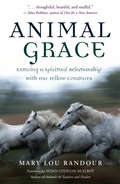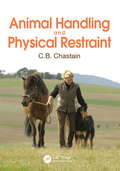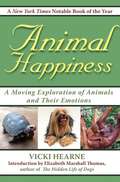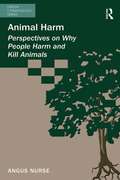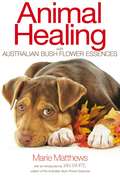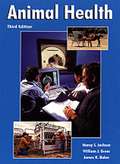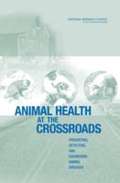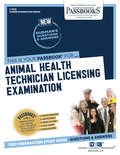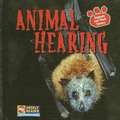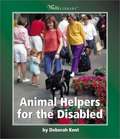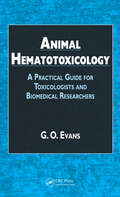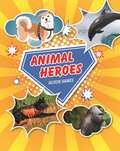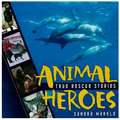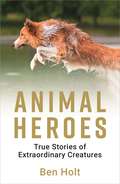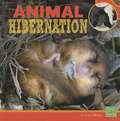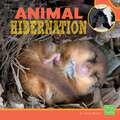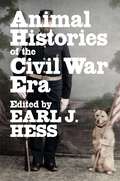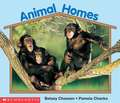- Table View
- List View
Animal Friendships
by Anne Innis DaggResearch into social behaviour in animals has often focused on aggression, yet members of social species are far more likely to interact with each other in a positive way. Animal Friendships explores non-sexual bonding behaviours in a range of mammalian and avian species. Through analysis of factors which trigger and deepen friendships, Dagg uncovers a world of intricate and complex social interactions. These factors include sources of food, formation of coalitions, playdates for infants, mutual grooming and the apparent pleasure of simple companionship. Chapters cover different types of friendship: from those between two individuals, such as male-female or parent-offspring friendships, to those within family groups and even inter-species friendships. Not only does the book explore how and why friendships form, it also showcases the ingenious field techniques used by researchers enabling the reader to understand the scientific methodology. An invaluable read for both researchers and students studying animal social bonding.
Animal Grace
by Mary Lou RandourAnimal Grace explores the human-animal relationship as a path to enlightenment. Randour calls for readers to examine how their lives intersect with members of other species and ensure that those interactions are based on compassion and respect.
Animal Group Behavior (Life Science Ser.)
by Abbie DunneSimple text and bright photographs explain the concept of animal group behavior for beginning readers. The book concludes with a simple, kid-friendly activity.
Animal Habitats: The Best Home of All
by Nancy PembertonA simple introduction to the different kinds of homes of different kinds of animals.
Animal Handling and Physical Restraint
by C. ChastainKey features: Stresses safety in handling, restraint, and containment of animals Covers handling and restraint of all domestic and common tamed animals and provides information on normal animal behavior and welfare Discusses how to recognize signs in animals of poor handling and containment Reviews zoonotic disease risks to animal handlers, particularly from normal-appearing animals, and how to avoid transmission of disease Features over 200 informative line drawings for clarity and simplicity of illustration Explains how to tie useful knots and hitches and when to use them for restraint Includes basic ethical considerations and legal liabilities of animal handling and containment Presents steps to prevent animal escapes, barn fires, and problems with transport Authored by an experienced veterinary educator in clinical medicine for veterinarians, veterinary students, pre-veterinary students, veterinary technicians and technologists, animal scientists, and animal owners Proper handling and restraint are essential to the welfare of captive animals, allowing them to be examined, groomed and treated in ways that contribute to their optimum quantity and quality of life. The aim of the book is to prepare future or current veterinarians and veterinary technologists, technicians/nurses, and assistants to be able to handle animals more safely and gain the confidence of animals and their owners. In turn, they will be able to instruct owners in proper animal handling methods, reducing the risk of physical injury or mutual infectious diseases. Throughout the book, the author emphasises that each animal is an individual and each handling environment provides its own advantages and disadvantages: handling an animal safely, humanely and efficiently requires practical knowledge of the species’ normal behaviour. This is explored in detail in each of the species-based chapters, which cover proper handling of domestic household and laboratory animals, as well as farm and ranch animals where safe handling aids the producer in both humane practice and greater profitability. After reading this book, the practitioner or student will be versed in the most basic part of the art of veterinary medicine: the safe handling of animals.
Animal Happiness: Moving Exploration of Animals and Their Emotions - From Cats and Dogs to Orangutans and Tortoises
by Elizabeth Marshall Thomas Vicki HearneA New York Times Notable Book of 1994! Highly respected author, philosopher, and animal trainer Vicki Hearne offers a treasure trove of animal anecdotes, all written in her unique and poetic style. Through entertaining stories about cats, horses, an ornamental carp, a scorpion, and tortoises, Hearne focuses on how each of these various creatures experiences happiness in its own special way. She takes issue with Ludwig Wittgenstein on lions and language, discusses the naming of pets, and considers the process of mourning a loved dog's death.
Animal Harm: Perspectives on Why People Harm and Kill Animals (Green Criminology)
by Angus NurseWhy do people harm, injure, torture and kill animals? This book evaluates the reasons why these crimes are committed and outlines the characteristics of the animal offender. It considers ethical and value judgements made about animals and the tacit acknowledgement and justification of unacceptable criminal behaviour towards the harming of animals made by offenders. Situating animal abuse, wildlife crime, illegal wildlife trading and other unlawful activities directed at animals firmly within Green Criminology, the book contends that this is a distinct, multi-dimensional type of criminality which persists despite the introduction of relevant legislation. Taking a broad approach, the book considers the killing and harming of animals in an international context and examines the effectiveness of current legislation, policy and sentencing. Including a section on further reading and useful organizations, this book is a valuable exploration into perspectives on the responsibility owed by man to animals as part of broader ecological and legal concerns. It will interest criminologists, ecologists, animal protectionists and those interested in law and society and law and the environment.
Animal Healing with Australian Bush Flower Essences
by Marie MatthewsCarefully researched and comprehensive, this reference gives extraordinary insights into the emotional world of animals and explores the healing powers of Australian Bush Flower Essences. Providing practical hints for keeping creatures fit and happy as well as dealing with health and behavior problems, this helpful guide offers naturopathic remedies that are both safe and time saving. Exploring a variety of case studies, particular Australian Bush Flower Essences are recommended to support sound management, balanced diet, and exercise by stabilizing the energy that is essential for the well-being of animals. While this handbook focuses primarily on dogs, cats, horses, and birds, more exotic creatures are covered in the Repertory of Symptoms section offered at the close.
Animal Health (Third Edition)
by Nancy S. Jackson William J. Greer James K. BakerAnimal Health provides basic information on animal health and disease prevention. The responsibility for animal health rests first and foremost in the hands of the owner.
Animal Health At The Crossroads: Preventing, Detecting, And Diagnosing Animal Diseases
by Committee on Assessing the Nation's Framework for Addressing Animal DiseasesThe confirmed case of "mad cow" disease (BSE) in June 2005 illustrates the economic impact of disease outbreaks, as additional countries closed their markets to U.S. beef and beef products. Emerging diseases also threaten public health--11 out of 12 of the major global disease outbreaks over the last decade were from zoonotic agents (that spread from animals to humans). Animal Health at the Crossroads: Preventing, Detecting, and Diagnosing Animal Diseases finds that, in general, the U.S. animal health framework has been slow to take advantage of state-of-the-art technologies being used now to protect public health; better diagnostic tests for identifying all animal diseases should be made a priority. The report also recommends that the nation establish a high-level, authoritative, and accountable coordinating mechanism to engage and enhance partnerships among local, state, and federal agencies, and the private sector.
Animal Health Technician Licensing Examination: Passbooks Study Guide (Career Examination Series)
by National Learning CorporationThe Animal Health Technician Licensing Examination Passbook® prepares you for your test by allowing you to take practice exams in the subjects you need to study. It provides hundreds of questions and answers in the areas that will likely be covered on your upcoming exam, including but not limited to: basic sciences; clinical sciences; animal sciences and record-keeping; and more.
Animal Helpers for the Disabled
by Deborah KentWritten for children in the middle grades, this book gives a brief history of the assistance-dog movement and the many ways in which dogs (as well as, in some instances, other animals) work as partners with people with disabilities. Chapters explore how assistance dogs are trained, living with an assistance dog, and legislation regarding access to public accommodations.
Animal Hematotoxicology: A Practical Guide for Toxicologists and Biomedical Researchers
by G.O. EvansHematology data from in vivo toxicology studies remains one of the most predictive measures for human risk, as the same measurements made in pre-clinical toxicology studies can be made in early clinical trials.Covering the three main blood cell types - erythrocytes, leukocytes and thrombocytes, this work is designed to clarify topics fo
Animal Heroes: True Rescue Stories
by Sandra MarkleA guide dog leads its owner to safety down seventy-seven flights of stairs in the World Trade Center before the building collapses. A female gorilla in a zoo picks up and protects an unconscious toddler who falls into her enclosure. An elderly dog named Frisky keeps his owner awake and alive when Hurricane Katrina floods the house. Winnie the cat saves her owners from carbon monoxide poisoning. Animals, both wild and domestic, have become heroes when they've come to the rescue of humans. In these heartwarming, true stories, Sandra Markle shows how dogs, cats, cows, monkeys, and even dolphins use their normal senses or special training to help people in trouble or in need all over the world.
Animal Heroes: True Stories of Extraordinary Creatures
by Ben HoltAnimal Heroes contains some of the most extraordinary true tales of bravery across the natural world, from domestic pets to wild animals, proving that when it comes to facing danger there’s more to them than meets the eye.
Animal Heroes: True Stories of Extraordinary Creatures
by Ben HoltAnimal Heroes contains some of the most extraordinary true tales of bravery across the natural world, from domestic pets to wild animals, proving that when it comes to facing danger there’s more to them than meets the eye.
Animal Hibernation
by Jeanie MebaneExplores the amazing ways that different animals hibernate to survive the winter.
Animal Hibernation (Learn About Animal Behavior Ser.)
by Imogene Barry MebaneWhy do aquatic frogs spend the winter buried in mud? Why to garter snakes coil together in dens? Animals hibernate in some unique ways. Discover the amazing ways hibernating animals spend the winter.
Animal Histories of the Civil War Era (Conflicting Worlds: New Dimensions of the American Civil War)
by Mark Smith Michael Woods Jason Phillips Brian Matthew Jordan Lorien Foote Abraham Gibson Joan Cashin Daniel Vandersommers David Gerleman Paula TarankowAnimals mattered in the Civil War. Horses and mules powered the Union and Confederate armies, providing mobility for wagons, pulling artillery pieces, and serving as fighting platforms for cavalrymen. Drafted to support the war effort, horses often died or suffered terrible wounds on the battlefield. Raging diseases also swept through army herds and killed tens of thousands of other equines. In addition to weaponized animals such as horses, pets of all kinds accompanied nearly every regiment during the war. Dogs commonly served as unit mascots and were also used in combat against the enemy. Living and fighting in the natural environment, soldiers often encountered a variety of wild animals. They were pestered by many types of insects, marveled at exotic fish while being transported along the coasts, and took shots at alligators in the swamps along the lower Mississippi River basin.Animal Histories of the Civil War Era charts a path to understanding how the animal world became deeply involved in the most divisive moment in American history. In addition to discussions on the dominant role of horses in the war, one essay describes the use of camels by individuals attempting to spread slavery in the American Southwest in the antebellum period. Another explores how smaller wildlife, including bees and other insects, affected soldiers and were in turn affected by them. One piece focuses on the congressional debate surrounding the creation of a national zoo, while another tells the story of how the famous show horse Beautiful Jim Key and his owner, a former slave, exposed sectional and racial fault lines after the war. Other topics include canines, hogs, vegetarianism, and animals as veterans in post–Civil War America.The contributors to this volume—scholars of animal history and Civil War historians—argue for an animal-centered narrative to complement the human-centered accounts of the war. Animal Histories of the Civil War Era reveals that warfare had a poignant effect on animals. It also argues that animals played a vital role as participants in the most consequential conflict in American history. It is time to recognize and appreciate the animal experience of the Civil War period.
Animal Homes
by Pamela Chanko Bestey ChessenSimple text describe the habitats of different animals.
Animal Homes
by Tammy Jones Margie Burton Cathy FrenchPerform this script about two policemen who investigate a murder mystery.
